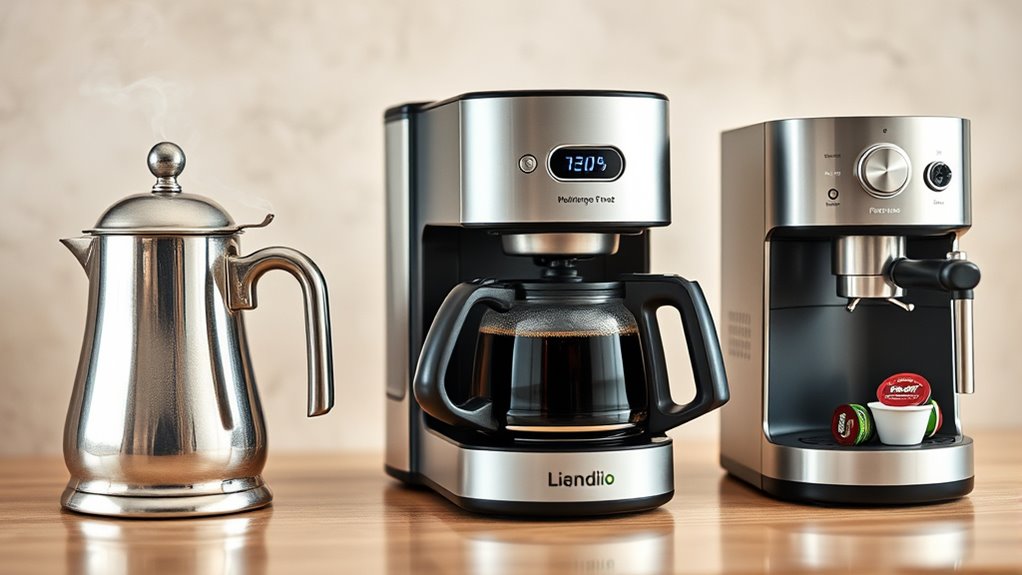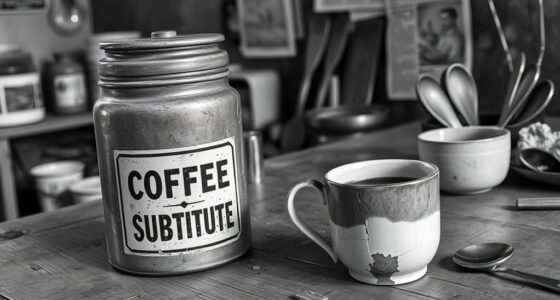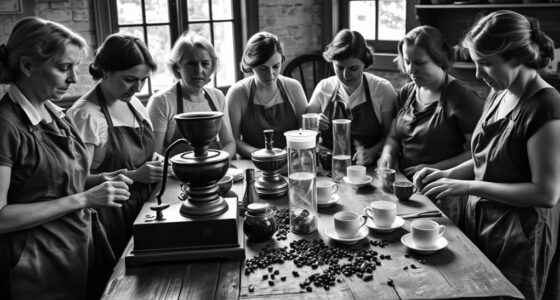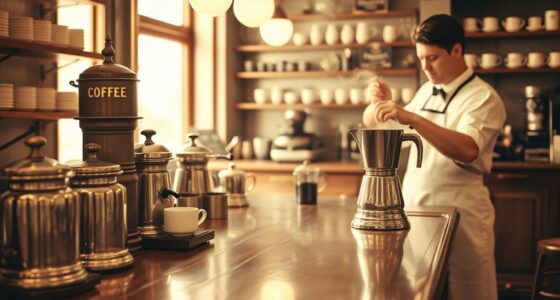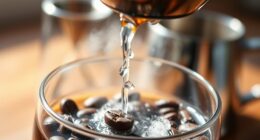You’ve seen how home coffee brewing has evolved from percolators, which brewed strong, classic coffee, to modern convenience like pods offering quick, consistent cups. Along the way, technological advances introduced French presses, cold brew makers, and heated brewers, giving you more control and flavor options. These innovations reflect your changing tastes and desire for personalized brewing experiences. If you stay curious, you’ll uncover even more about how this journey continues to enhance your coffee rituals.
Key Takeaways
- Home coffee brewing has evolved from traditional percolators to modern single-serve pods, offering greater convenience and variety.
- Innovations like French presses and cold brew makers introduced new brewing styles emphasizing flavor control and customization.
- Technological advances have led to automated and programmable machines, simplifying coffee preparation for everyday use.
- The shift towards specialty methods reflects consumer desires for personalized, high-quality coffee experiences at home.
- Overall, this evolution showcases increased accessibility, efficiency, and diversity in home coffee brewing options.
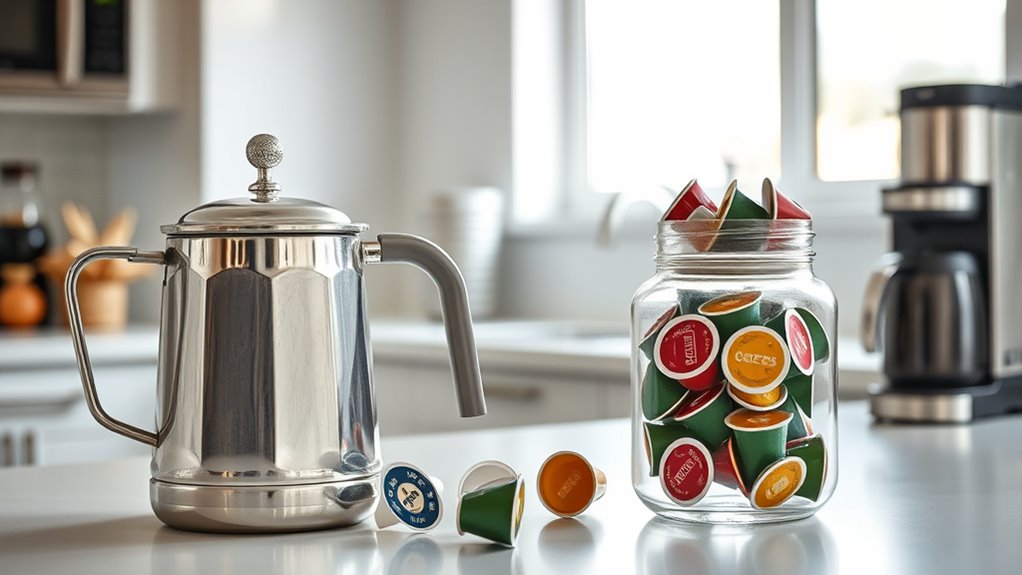
The French press remains a popular choice because it’s simple, affordable, and produces rich, full-bodied coffee. You add coarsely ground beans, pour hot water over them, and let it steep for several minutes. When you press down the plunger, you separate the grounds from the liquid, resulting in a robust brew that captures the coffee’s natural oils and flavors. This method appeals to those who want control over brewing time and strength, and it’s ideal for making small batches quickly at home. Additionally, the color accuracy of the brewing process can influence the perceived richness and depth of flavor in your coffee.
Cold brew has also gained momentum, especially for those seeking a smoother, less acidic coffee. To make cold brew, you steep coarsely ground beans in cold water for 12 to 24 hours. You then filter out the grounds, leaving a concentrated coffee that can be refrigerated and enjoyed over several days. The process requires no heat, making it energy-efficient and convenient. Cold brew’s mellow, chocolatey notes are perfect for hot weather or when you prefer a different flavor profile compared to hot brewed coffee. Plus, you can use cold brew as a base for various beverages, from coffee smoothies to iced lattes.
Advances in technology have made both these methods more accessible. Today, you can find specialized French press models with insulated bodies or built-in timers, and cold brew makers that simplify the steeping process. These innovations make it easier to experiment with different brewing techniques at home without investing in expensive equipment. Additionally, versatile sizes for different brew quantities have helped enthusiasts customize their coffee experience to suit their needs and preferences. Furthermore, as your tastes evolve, you can switch effortlessly between methods, enjoying everything from the boldness of French press coffee to the invigorating chill of cold brew.
In essence, the evolution of home coffee brewing reflects a desire for personalization and quality. Whether you prefer the hands-on ritual of a French press or the effortless convenience of cold brew, these methods empower you to craft coffee exactly how you like it. With ongoing technological advances, your options will only expand, giving you more ways to enjoy your daily coffee ritual at home.
Frequently Asked Questions
How Do Coffee Brewing Methods Affect Flavor Profiles?
You can see how brewing methods impact flavor profiles through flavor extraction and bean interaction. For example, espresso’s quick extraction highlights bold, intense flavors, while drip brewing offers a lighter, nuanced taste. The method’s pressure, temperature, and brew time influence how the beans’ oils and acids interact, shaping your coffee’s overall flavor. So, choosing a brewing method directly affects the richness, acidity, and balance of your cup.
What Are the Environmental Impacts of Different Coffee Makers?
Did you know that single-use coffee pods generate over 10 billion pounds of waste annually? Your choice of coffee maker impacts the environment through energy consumption and materials used. Opting for machines made from sustainable materials reduces waste, while energy-efficient models lower your carbon footprint. By choosing eco-friendly options, you help minimize landfill waste and conserve resources, making your daily coffee routine more sustainable and environmentally responsible.
How Has Coffee Machine Technology Improved Over Time?
You’ve seen how coffee machine technology has improved through the years. Manual grinding once required effort, but now automated brewing makes it quick and easy. Modern machines offer precise temperature control, built-in grinders, and customizable settings. You can enjoy fresh, perfectly brewed coffee at home without the hassle. These advancements save time, improve flavor, and make coffee brewing more accessible, transforming the way you start your day.
What Are the Cost Differences Between Brewing Methods?
Imagine stumbling upon a coffee shop secret: your brewing method’s cost efficiency impacts your wallet. You find that simple drip machines usually cost less upfront and have lower maintenance costs, making them economical. Meanwhile, single-serve pod machines might seem convenient but can rack up expenses over time. By choosing wisely, you save money while enjoying your perfect brew, balancing initial costs and ongoing maintenance for the best value.
How Do Brewing Techniques Influence Caffeine Content?
You should know that your brewing technique directly impacts caffeine content. Instant brewing often yields less caffeine per serving, while methods like pour-over or espresso can extract more, providing a stronger kick. Consistent brewing techniques help you control caffeine levels, so you get the same strength each time. Variations in grind size, brew time, and temperature influence caffeine extraction, making brewing consistency essential for achieving your desired caffeine intake.
Conclusion
As you’ve seen, home coffee brewing has come a long way, with each new method opening doors to richer flavors and greater convenience. From percolators to pods, it’s clear that technology keeps pushing us forward. Remember, when it comes to brewing your perfect cup, it’s all about finding what works best for you. Don’t be afraid to try different techniques—you might just find your golden ticket to coffee bliss. Keep experimenting and enjoy the journey!
